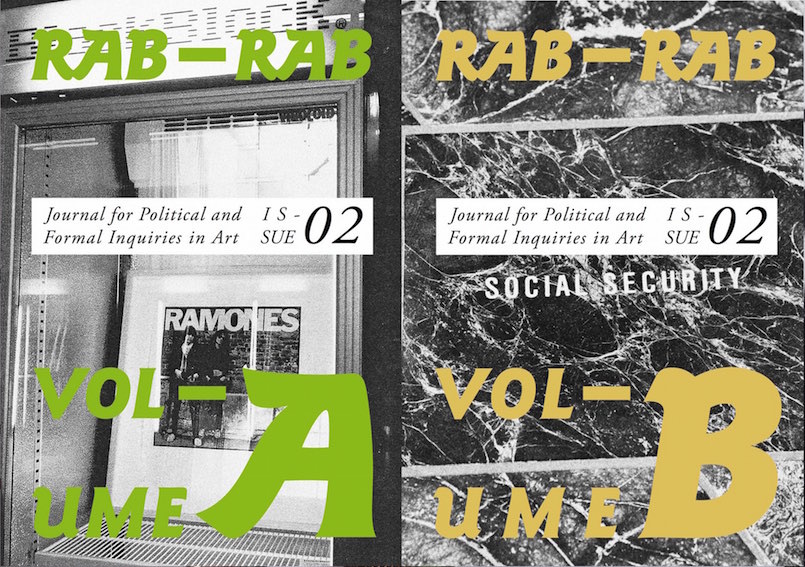Rab-Rab: Journal for Political and Formal Inquiries in Art, 2 (2015)
Filed under magazine | Tags: · art history, avant-garde, film, futurism, music, music criticism, noise

“The second issue of Rab-Rab is in two volumes, all together in 500 pages. The focus of the second issue is ‘noise against culture.’ The contributions deal with the formal theory of noise, politics of contradictions, the device of estrangement, materialist film, music and violence, Futurism, Russian avant-garde, improvisation, void, heterophonies, swearwords, communism, ideologies of marriage, class wars and electricity.
Departing from our programme based on the understanding of art practice as a confrontation between formal and political inquiries, our aim in this issue is to use noise as the name for this difficult, disturbing, loud and coercive exploration. In many cases the formal and political aspects of noise are two separate things: the former is seen as an issue of information or perception, whereas the latter is usually reduced to a metaphor of spontaneity. But if we change these parameters of discussing the noise from measurable coefficients of failed communication, or from elusive metaphors of contingencies, towards the conceptual references related to ideology and class struggles, then what is understood as noise turns into something else. It can become a valid concept of inquiry, refusing to be pinpointed to conventional academic banalities silly phenomenological artistic fantasies immersed in.”
Contributors to volume A: Dror Feiler, Mazen Kerbaj, Ozren Pupovac, Ben Watson, Michel Chevalier, Jean-Claude Moineau, Taneli Viitahuhta, Henrik Heinonen, Grégoire Rousseau, Bruno Besana, Ivana Momčilović, and François Nicolas.
Contributors to volume B: Darko Suvin, Anthony Iles, Grupa za Konceptualnu Politiku, Mattin, Jyrki Siukonen, Rahel Puffert, Martin Krenn, Jaakko Karhunen, Max Ryynänen, Antti Eskelinen – Eze, Gert Raeithel, Aeron Bergman, Alejandra Salinas, Milica Tomić, Christine Delphy, Peter Gidal, Giovanna Esposito-Yussif, Kari Yli-Annala and Sezgin Boynik.
Edited by Sezgin Boynik
Publisher Rab-Rab Press, Helsinki, Sep 2015
ISSN 2342-4885
278 & 278 pages
Publisher (Issue 2A)
Publisher (Issue 2B)
Issue 2A: PDF, PDF
Issue 2B: PDF, PDF
Tuned City: Between Sound and Space Speculation (2008)
Filed under book | Tags: · acoustics, architecture, city, noise, sound, sound studies

“Sounds belong to the City. They determine spaces and identities. For years, artists have been using city noises as a material to stage or to question urban space – new territory, however, for most architects and planners within the routines of functional planning procedures. Tuned City – Between Sound and Space Speculation searches for a new evaluation of architectural spaces from the perspective of acoustics. This volume presents various positions of architects, artists and theorists to expand the architectural discourse with the dimension of listening. ”
The English section runs from the page 97-192.
Contributions by Doris Kleilein and Anne Kockelkorn, Barry Blesser and Linda-Ruth Salter, Gisela Herzog and Gerhard Steinke, Susanne Hauser, Thomas Ankersmit, Pascal Amphoux and Grégoire Chelkoff, Raviv Ganchrow, Mark Bain, Arno Brandlhuber and Markus Emde, Michael Bull, Stefan Kölsch, and Jacob Kirkegaard.
Edited by Doris Kleilein, Anne Kockelkorn, Gesine Pagels, and Carsten Stabenow
Publisher Kook Books, Idstein, 2008
Reihe Essay series, 4
ISBN 9783937445366, 3937445366
192 pages
Reviews: Rahma Khazam (The Wire, 2008), Alessandro Ludovico (Neural, 2009).
Project website
Project website (book)
WorldCat
PDF, PDF (10 MB)
See also catalogues from Tuned City editions in Berlin (2008), Tallinn (2011), Brussels (2013), and Athens (2018).
Purple Noise: An Exhibition Turned Into an Global Feminist Protest Turned Into a Catalogue (2018)
Filed under artist publishing | Tags: · cyberfeminism, feminism, noise, social media, technology

“In the summer of 2018, a German artist, famous for having a past as cyberfeminist and a present as technofeminist, was invited to Stuttgart in the South of Germany, to create an exhibition dealing with issues of gender and technology as part of a large festival. During her research, she got in touch with numerous fellow artists and activists, and in a process of collective realization, they found that the time has come, not for another exhibition, but for a global technofeminist upheaval.
Learning from the dark forces that understand how to manipulate national referenda and presidential elections, they flooded social media platforms – an area they had previously avoided in order to protest against the centralisation and privatisation of digital communication. Very quickly, however, they have learned how to “motivate” thousands of followers, how to “inspire” them to like and “share” their contents, and even to contribute their own agendas. Within a few weeks, what had started as a small protest, has grown exponentially and conquered not just the Net but also traditional media. They gained enormous power, more than they ever imagined, and now decisions have to be made on how to use this power. Come and help us decide! What would you do if you had power over the Internet – and thus the real world?”
Produced for Monoskop’s Exhibition Library in the 2018 Seoul Mediacity Biennale, 6 September–18 November 2018 at the Seoul Museum of Art.
Self-published in collaboration with Monoskop, Amsterdam, August 2018
[14] pages
PDF (4 MB)
Comment (0)
